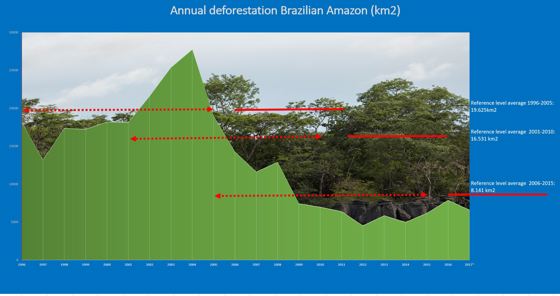Brazil sees reduced payments from Norway following increased deforestation in the Amazon
Historical archive
Published under: Solberg's Government
Publisher: Ministry of Climate and Environment
News story | Date: 08/12/2017
Norway's rainforest payment to Brazil is sharply reduced this year compared with last year. Brazil is paid NOK 350 million (~ USD 42 million) based on the deforestation rate in the Amazon in 2016. The reduction is due to increased deforestation and tighter requirements for the results that Brazil must deliver in order to get paid. –This shows that the results based system is working, says Norway's Minister of Climate and Environment Vidar Helgesen. - When deforestation goes up, payments go down. –I am however pleased to notice that initial deforestation figures for 2017 show a reduction. If confirmed, this would lead to increased payments next year, says the minister.
Reduced deforestation in Brazil's Amazon in the last decade has been one of the world's most important measures to mitigate climate change. Tropical rainforests bind a lot of carbon, and when the forests disappear, the carbon enters the atmosphere as the greenhouse gas CO2.

During the forest year 2016 (August 2015-June 2016) deforestation in Brazil's part of the Amazon increased by a substantial 27 percent compared to the year before.
Total deforestation amounted to 7.893 km², an area about one quarter the size of Belgium.
Reduced payments
The combination of increased deforestation and stricter reference levels in the agreement with Brazil reduces this year's payment from Norway to NOK 350 million. This is a sharp decline from previous years, with contributions on average NOK 925 million annually in the period 2009-2016.
–Reduction in the annual payment must in no way be understood as a weakening of our obligations to Brazil. The payment is in accordance with the cooperation model where Norway pays for results in Brazil. This model has Brazil itself developed, says Helgesen.
Brazil is paid for reduced climate emissions if verified deforestation in the Amazon one year is lower than the average deforestation of a previous 10 year period. The average is called baseline or reference level. In the agreement between Norway and Brazil, the baseline is adjusted every 5 years. If the deforestation goes down, the reference level is also adjusted downwards over time. The system is built so it becomes increasingly demanding over time for Brazil to achieve results that Norway pays for.
For 2016, the reference level was adjusted down by approx. 51%, from over 16,500km2 to just over 8,000 km2. This is because the average deforestation in 2006-2015 was correspondingly lower than in the period 2001-2010.
In a historical perspective, deforestation in the Brazilian Amazon is still low. The deforestation in 2016 is about 60 percent lower than in the decade 1996-2005. During this period, 19,500 km2 rainforest disappeared every year.
-The challenging situation Brazil has experienced in the last couple of years shows that progress cannot be taken for granted. I am pleased that the Brazilian authorities seem to have taken the increased deforestation seriously. They are still committed to keeping deforestation under control and return to the trend of reducing deforestation in the Amazon, says Vidar Helgesen.
Positive 2017 figures
Brazil's preliminary deforestation figures for the 2017 forest year announced in October indicate that deforestation in the Brazilian Amazon declined by 16 percent compared with 2016. If these figures are confirmed when the final figures are available in the autumn of 2018, it will provide a basis for increased payments next year, says the Norwegian minister.
–In the last year, Brazil has strengthened its efforts in the Amazon. According to the director of Brazil's environmental police IBAMA this is directly related to the Norwegian contributions.
The latest figures for 2017 indicate that deforestation has decreased, says Vidar Helgesen.
Since 2008, Norway has now contributed a total of NOK 7.7 billion (~USD 1 billion) to Brazil for reduced emissions from the Amazon. The funds are managed by the Amazon Fund and used to support important measures to reduce deforestation and promote sustainable forest management and development in the Amazon region. For example, Norwegian money has supported indigenous territories and expand national parks. Brazil's environmental police IBAMA, which combats illegal logging, has also received a lot of support.
The Norwegian money thus has a double effect. First and foremost, they reward the results, but they are also used for further measures to combat deforestation.